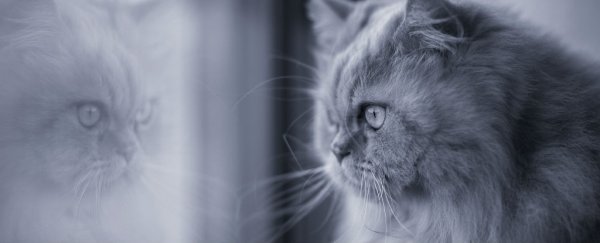Admit it, you've probably tried showing your dog or cat a mirror, just to see what would happen. And chances are they either completely ignored it, or freaked out thinking it was another dog or cat to attack - or play with. There's no shortage of adorable videos starring puppies versus mirrors, but the antics don't really explain whether an animal can actually recognise itself in the mirror.
Long before these YouTube observations, American psychologist Gordon Gallup Jr. devised a test to answer this very question. In 1970, he published a paper in Science claiming that chimpanzees could learn to recognise themselves. The investigation involved a simple yet effective test: four chimps were placed in isolated cages for 10 days, and had the companionship of a mirror for 8 hours a day.
At first the chimps treated their reflections as they would another chimp in a social setting. But within a few days, their behaviour changed. "They'd use the mirror to look at the inside of their mouths, to make faces at the mirror, to inspect their genitals, to remove mucous from the corner of their eyes," Gallup told Chelsea Wald at Nautilus.
In other words, the chimps appeared to have learnt to recognise their reflections. To be sure, Gallup tested this notion by going one step further - each animal was gently anesthetised and received some markings in the shape of red paint on one of their eyebrow ridges, and a tip of the ear. "It seemed pretty obvious that if I saw myself in a mirror with marks on my face, that I'd reach up and inspect those marks," said Gallup.
The removable red dye couldn't be smelled or felt by touch (the team actually tested this by painting their own faces first and waiting for 24 hours to see if they could feel it). Once returned to their mirrors, the chimps went on to do exactly what Gallup predicted - they inspected their new markings, even rubbing them with their hands and then checking their fingers to see if whatever had been painted on them was coming off.
This mirror self-recognition test has since become a staple in comparative psychology - the study of non-human animal behaviour. Humans have tried the test with many species, including a range of primates, mammals, and even birds, but only a handful of them have 'passed'. In other words, they were able to demonstrate interest in a coloured marking placed on their bodies.
Animals that react to the mark test include great apes such as chimps, bonobos, and orangutans, as well as Asian elephants, Eurasian magpies, bottlenose dolphins, and even orcas. Researchers have also had mixed results with gorillas. Meanwhile, when it comes to cats and dogs, their mirror-savvy is entirely lacking; but then monkeys don't fare any better, either - and neither do human babies up to the age of 18 months.
Not all researchers agree that noticing a splodge of red paint in the mirror is the same as being aware of yourself. But if we do accept that a mirror mark test tells us something about self-recognition in animals, then it seems to be limited to the kinds of species that get into complex social interactions with their kin. We humans certainly fall into that category.
